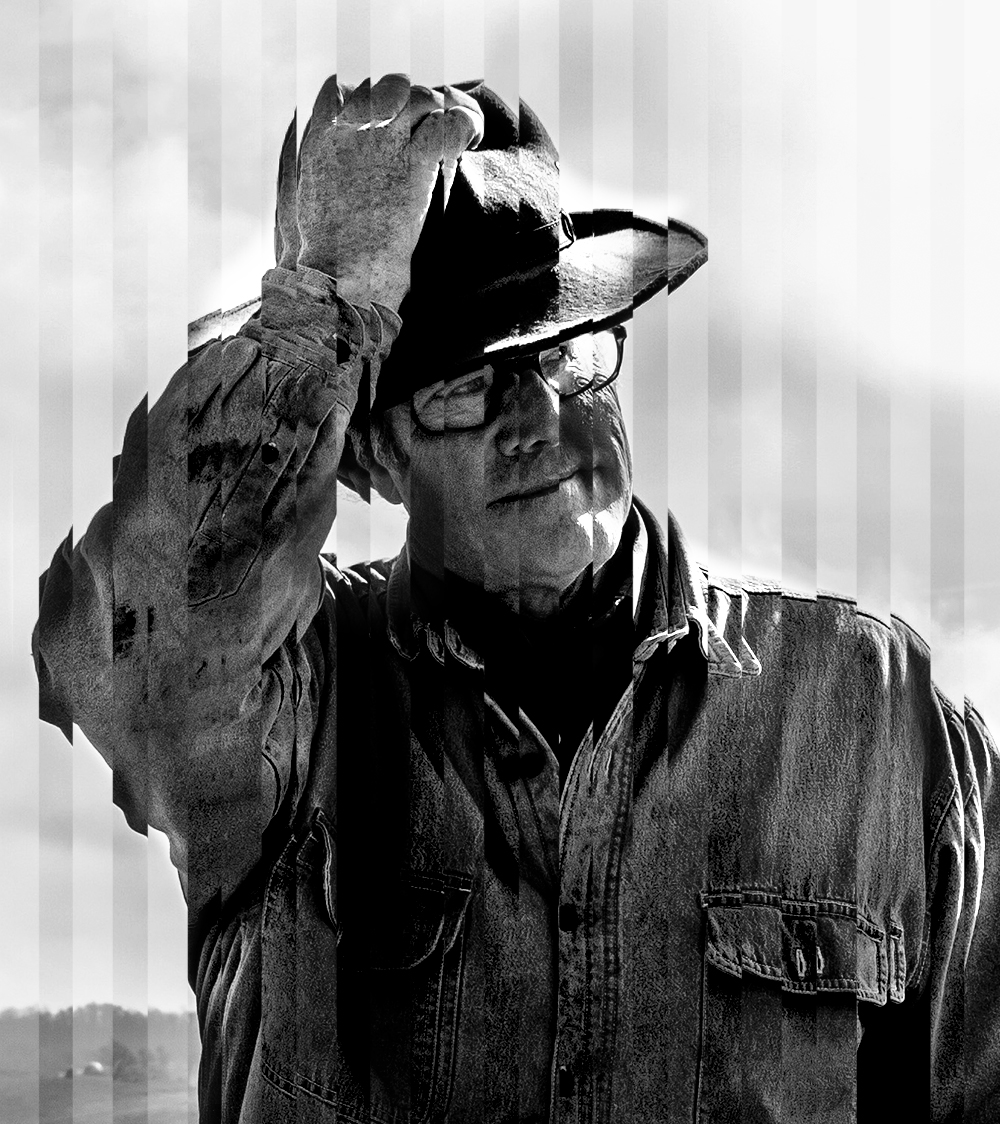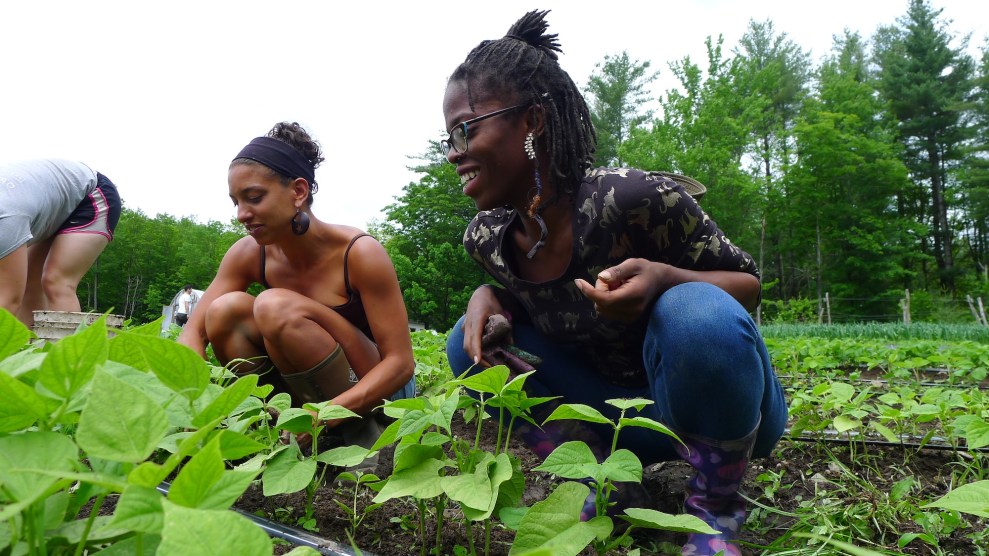A quarter century ago, a rebellion against industrialized farming arose in the very place where this chemical-intensive agriculture first took root. Farmers’ markets began to multiply in the United States, the land of the supermarket; farm-to-table restaurants became commonplace in our fast-food nation, the very one that gave the world McDonald’s.
It was here, in the sustainable-farming boom, that Joel Salatin made a name for himself. He was one of several media darlings of the movement, up there with best-selling author Michael Pollan and Berkeley restaurateur Alice Waters. The stars tended to be white, and they tended to gear their message to an audience prosperous enough to pay up for better food. But this was seen as a temporary flaw in an otherwise virtuous movement. Racial and class tensions simmered from the start, but were often ignored. A Black-led urban agriculture effort coincided with—and even preceded—the explosion of farmers’ markets in posh white enclaves, but these rumblings received little notice from the broader food world.
For nearly two decades, Salatin has been the movement’s most famous farmer. He burst onto the national scene in 2002, when Pollan wrote a paean in Gourmet Magazine to his ingenious pasture-based livestock-rearing techniques. Four years later, the self-proclaimed “lunatic farmer” starred in a large section of Pollan’s landmark bestseller The Omnivore’s Dilemma (excerpted by Mother Jones in 2006). The author summoned prose as lush as a summer prairie to describe Salatin’s operation, Polyface Farm, in Virginia’s Shenandoah Valley: It was “a scene of almost classical pastoral beauty—the meadows dotted with contented animals, the backdrop of woods, a twisting brook threading through it all—marred only by the fact that I couldn’t just lie here on this springy pasture, admiring it for the rest of the afternoon.”
For more articles read aloud: download the Audm iPhone app.
Pollan’s book helped propel Salatin’s career as a speaker and writer, and the farmer soon emerged as a fixture on the global sustainable-agriculture speaking circuit and authored many popular books. He snagged a starring role in the Oscar-nominated 2008 documentary Food, Inc.; the Guardian called him “America’s most celebrated pioneer of chemical-free farming,” and Time hailed him as the “world’s most innovative farmer.”
I’ve done my bit to raise Salatin’s profile. Impressed by what I read about how his multi-species rotational grazing technique churns out high-quality food while also building fertile soil, I more or less favorably reviewed two of his books, shared a stage with him twice, and even hosted him for dinner at the North Carolina farm where I once worked.
Lately, though, Salatin’s star has dimmed. Mother Earth News, long a beacon for homesteaders and beginning farmers looking to avoid the pitfalls of industrial agriculture, recently ended a longstanding association with Salatin that included a regular column and keynote speeches at events. In a widely shared September 4 Medium post, fellow Virginia farmer and blogger Chris Newman concluded that Salatin is a “great farmer, but somewhere along the way he got convinced that he can’t be a great farmer without being a bigot.”
To an emerging generation of aspiring growers, Salatin is less a beacon to a sustainable future than an example of Black and Indigenous erasure and nostalgia for a mythologized agrarian past. Along with a host of white food politics writers, I glorified Salatin, chalking up his occasional bursts of illiberalism to a sort of rough-hewn eccentricity. What I didn’t understand was that these things can’t be separated from his ideas about sustainable farming. It took Newman, the son of a Black mother and a Native American father, to make clear how they’re all connected.

In his 1998 manifesto You Can Farm: The Entrepreneur’s Guide to Start & $ucceed in a Farming Enterprise, Salatin crystallized his pitch to a new wave of small-scale farmers. “The aging farm population is creating cavernous niches begging to be filled by creative visionaries who will go in dynamic new directions,” he declared. “As the industrial agriculture complex crumbles and our society clambers for clean food, the countryside beckons anew with profitable farming opportunities.”
Salatin’s message reverberated through the alternative agriculture world when I joined a small organic farm in the Appalachian mountains of North Carolina in 2004. Our farm focused on vegetables, not meat; but in regional agriculture conferences and on blogs, I heard reverent buzz about Pastured Poultry Profit$ and its bovine sequel, Salad Bar Beef, Salatin’s how-to manuals for making a living off of livestock on small plots of pasture. In addition to providing widely respected technical farming advice on how to operate clever technology like the “mobile chicken tractors” that Salatin has made famous, the books promised to show the way to modest prosperity for anyone willing to make the jump into farming. “A couple working six months per year for 50 hours per week on 20 acres can net $25,000 to $30,000 per year with an investment equivalent to the price of one new medium-sized tractor,” Salatin proposed in his poultry book, first published in 1993. “Seldom has agriculture held out such a plum.” He added: “The pastured poultry opportunity shines like a beacon in the night, guiding the way to a brighter future.”
As for the obstacles new farmers might face? Salatin focused on burdensome regulation. A limited-government zealot, he addressed the Libertarian National Convention in 2020, where he preached the creed that the only thing holding back a small-farm renaissance are jack-booted government inspectors. He wrote a book laying out his libertarian analysis of the food system’s troubles, calling it Everything I Want to Do Is Illegal.
Seven years ago, Chris Newman followed Salatin’s call. Then a DC-based engineer, he had hoped to eventually retire with his wife, Annie, and farm on Virginia’s Northern Neck region near Chesapeake Bay (about three hours east of Polyface). They planned to raise bison and grow “really old varieties of corn that a lot of the seed keepers in this area keep and need propagated,” he told me. By producing these indigenous foodstuffs, the couple would be carrying on the agricultural heritage of Newman’s father, a member of the Piscataway Conoy Tribe, which has resided in the region around Chesapeake Bay’s western shore—including present-day Washington, DC, and Baltimore—for centuries, since long before European contact in the 1600s.
In 2013, Newman’s high-stress tech career led to a health scare, and the couple decided to speed up their agrarian timeline, starting on rented land. Drawing from “really solid advice” in Salatin’s books, the Newmans quickly shifted their farming strategy from their original retirement vision. Salatin’s work taught him that to “make a living as farmer, you need to sell stuff that has an established market.” Bison meat and heritage corn “need to be propagated and taken care of,” Newman decided, but for beginning farmers, “it’s a lot easier to build your house, so to speak, doing the normal stuff—chicken, beef, big red tomatoes—that you know people will buy.” So they debuted Sylvanaqua Farms, selling eggs, chicken, pork, and beef, raised by rotating the animals through pasture—the technique championed by Salatin.
But while the farming practices Newman learned from Salatin’s work proved “solid,” he said, the economics proved untenable. He and Annie found themselves stuck on a treadmill familiar to anyone (like me) who’s ever tried to scratch a living off of the land without leaning on low-paid hired labor. Consumers will pay only so much for food, no matter the quality or the soundness of the ecological practices behind it, so profit margins are painfully tight. To make a living, you have to scale up—but that means increasing an already-punishing workload, and also scrambling for investment capital that will have to be paid back. The result is an avalanche of stress that doesn’t get a lot of play in Salatin’s chirpy how-to manuals.
So the Newmans began rethinking the model, deciding that Salatin’s individualistic go-it-alone credo was always bunkum—and that his personal success story had little relevance to most would-be farmers, unless they have loads of resources to burn.

Salatin inherited the land that became Polyface Farm from his father, according to his account in You Can Farm. Salatin’s father had worked as an accountant at a major US petroleum company, crunching numbers for their “wildcat oil drilling ventures” in Venezuela. “It was a high-paying occupation,” Salatin wrote, and his father “squirreled away every dime,” eventually plunging his savings into a “1,000-acre highland farm” purchased from an “elderly señora” in Venezuela. Salatin’s father moved young Joel and the rest of his family there, and “began clearing some of the jungle” to establish a chicken and a cow-dairy operation. The farm operated “in a totally free market…without government regulations” and “very quickly cornered the [local] poultry market,” Salatin reported.
This expat agrarian triumph shattered in 1959, when a “Communist-instigated revolution rocked the country” and “people came in and took over our farm,” Salatin states. (In reality, President Rómulo Betancourt, no Communist, was democratically elected in 1958 in the wake of a military coup earlier that year. Betancourt did institute a program to redistribute some land, because “1.7 percent of the landholders own 74 percent of the land,” Time reported in 1959.) Ultimately, the Salatins resettled in Virginia and bought a “worn-out farm” in the Shenandoah Valley. Using a “token” payment from the Venezuelan government for the lost land there, “Dad bought 28 Hereford cows and started farming again.” Thus Polyface—100 acres of open land, 450 more in woods—was born. By 2015, according to the trade journal Progressive Farmer, the operation boasted annual sales of $2 million.
While Joel Salatin deserves credit for his ingenious management of this land, his recipe for success is not as easy to follow as he insists. Few aspiring farmers have the advantage of inheriting a swath of flat terrain well-tended by the previous generation—or have the resources to make crucial investments, such as the slaughterhouse, T&E Meats, that Salatin bought with another investor in 2007 and that now processes Polyface’s meat.
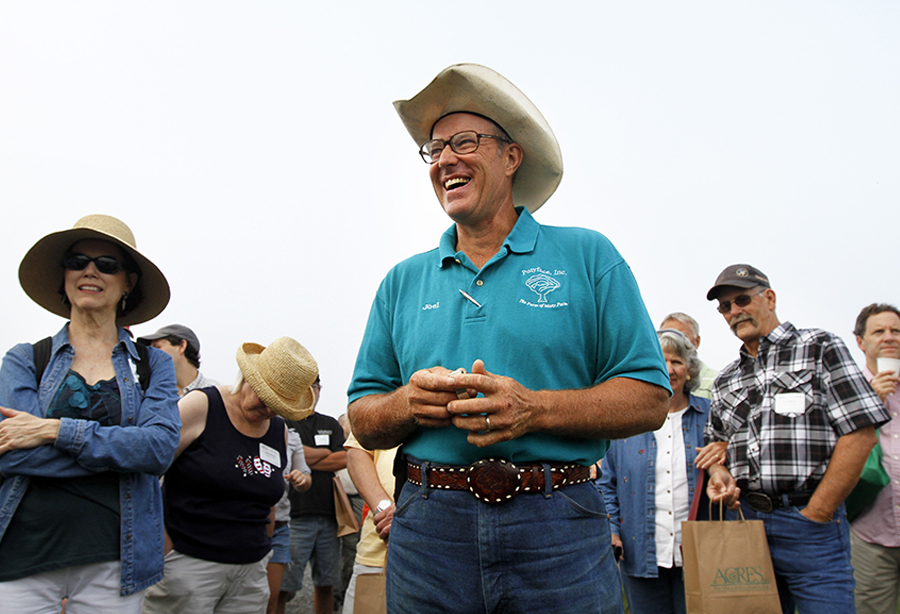
Joel Salatin, owner of Polyface Farm, jokes with a small crowd before setting out on a tour of the farm in July 2011 in Swoope, Va.
Norm Shafer/The Washington Post/Getty
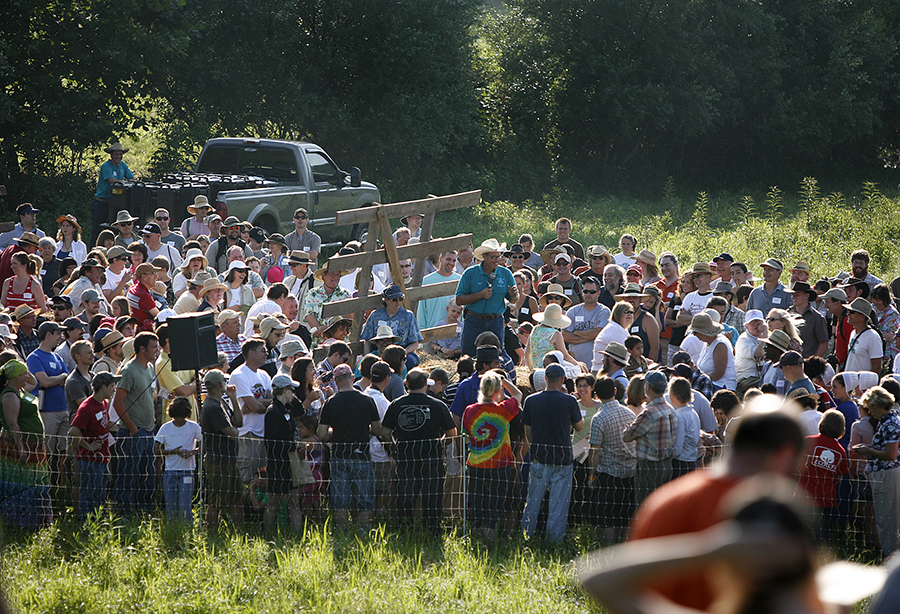
Close to 1700 people came to the farm to learn about his pasture-based method of farming.
Norm Shafer/The Washington Post/Getty
It’s no surprise, then, that the individualist agrarian approach promoted by Salatin—small farms selling their wares directly to consumers—has failed to challenge industrial agriculture’s grip on the US landscape and diet, Newman argued in a July 2019 blog post published on Heated, a Medium site, entitled: “Small Family Farms Aren’t the Answer.” Newman cited US Department of Agriculture data showing that the local-food revival heralded by Salatin remains severely limited: Small operations selling food nearby still account for less than 3 percent of the country’s “household calories” and just 1.5 percent of agricultural production by cash value.
Whereas people like Salatin like to hark back to the Jeffersonian notion of individual yeoman farmers—glossing over the slavery that underpinned it—Newman looked further into the past of this continent:
America’s oldest farmers—Indigenous people—generally regarded the soil as a commons and worked it cooperatively. Many Indigenous nations, along with a number of religious and ethnic communities, continue the practice to this day. But the notion of the private farm, be it a pair of greenhouses or tens of thousands of acres, is what came to dominate American farming, and it’s taken particular hold among the farm-to-table cohort.
Bewitched by the lone-wolf agrarian myth, Newman argues, new farmers “trade the benefits of agrarian collectivism—living wages, retirement, a sane workload, profitability, survivability, and the capacity to make a game-changing impact in the marketplace,” for rugged independence: “complete autonomy in decision-making, the ability to grow what/where/how we want, set our prices as we please, sell wherever we choose, and work ourselves into the ground.” He added: “In short, we’ve done the most modern-American thing possible: bartered away our quality of life for the freedom to be miserable.”
Although Newman’s post didn’t mention Salatin, the older farmer registered his offense at its ideas in a November 2019 post on his personal blog called “Whining and Entitlement.” He disdained Newman’s analysis of the go-it-alone approach. “The idea that entrepreneurs, as individuals and families, cannot be successful is to fall prey to a victimhood mentality,” he argued, using a favorite phrase of conservative polemicists who want to belittle any suggestion there might be structural impediments facing Black people. “Chris has been farming for what, 6 years? My goodness, Teresa [Salatin’s wife] and I weren’t sure we’d even be able to make until we were about 5 years in. If I’d posted all my musings regarding our struggles, insecurity, and discouragement in those early years I’d have been both wrong and prejudicial.”
Salatin defended the sanctity of the lone individual: “While I’m a huge believer in collaboration and building community, I’m equally excited about individual leadership and entrepreneurship,” he wrote. “The two are not mutually exclusive; they are indeed mutually beneficial. But usually community coalesces around individual leadership.”
Salatin never answered the charge that the individualistic approach to successful farming he champions presumes previously acquired wealth—and instead chose to focus his riposte on Newman’s race:
The problem with disagreeing with Chris is that I’ll be called a racist. That’s unfortunate. Is it more racist to play the race card to anybody who dares disagree with you than it is to actually be a racist? I’m bringing this up because all races need to understand that when you use that term, it shuts down all communication. So I’m going out on a limb here in saying anything negative about someone who is not white. For non-whites to assume the default “racist!” accusation fits most circumstances is to stall forward progress. Period.
Then Salatin deployed a bluntly settler-colonial metaphor, complete with a reference to Native Americans as persecutors of the entitled white pioneer at the vanguard of Westward expansion. Leadership, he declared, “requires someone to leave the fort first, maybe take some arrows, lead into the frontier.” He ended his piece with a bizarre tribute to William Cody, also known as Buffalo Bill, as a role model for youth today. Cody is famed for his role in land-grabbing wars against Indigenous peoples in the 19th century. “When I think of William Cody mounting a US Postal Service Pony Express horse at the age of 13 and riding through paths lined with hostile Native Americans, I wonder where he is today. Fortunately, he’s here; rare, but here. Not the norm, but I’m sure glad some are still here.”
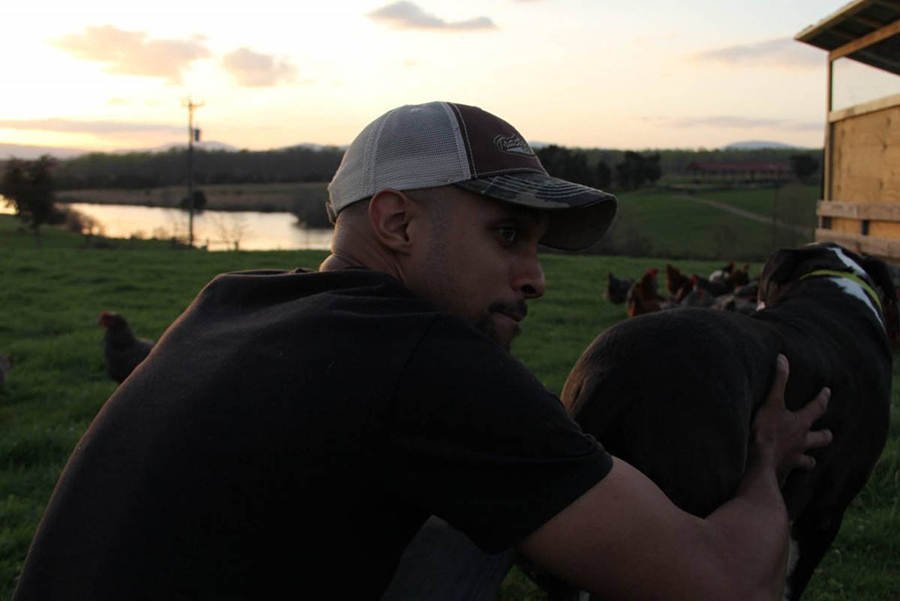
Chris Newman.
Courtesy of Sylvanaqua Farms
If Salatin thought his post had routed Newman and ended the argument, he was wrong. The battle shifted to the terrain of Mother Earth News, a longtime forum for Salatin’s writing. Last summer, the journal invited Newman to contribute articles in an attempt to diversify the voices it highlights in the wake of the George Floyd murder and subsequent racial-justice protests. Newman declined, citing Salatin’s ongoing publication in the magazine. “Salatin penned an appallingly racist screed about me in response to one of my essays on small farming back in November,” he wrote in an email to a Mother Earth News staffer. “Until and unless this is addressed, I must assume Ogden’s [MEN’s parent company] endorsement of the above and cannot pursue this further.”
The magazine was slow to respond to Newman. In the meantime, Newman aired his complaint as comments on Mother Earth News’ Instagram posts, and other critics joined in. Mother Earth News initially responded by deleting the posts, adding fuel to what became a firestorm in the sustainable-agriculture world. Mother Earth News publisher Bill Uhler told me that staffing reductions were the main driver of the slow response, and he described the social-media deletions as an “unfortunate” decision.
Clara Coleman, a Maine farmer, told me that she was one of many people who criticized Mother Earth News on social media over the summer for not responding to Newman and not publicly discussing its relationship with Salatin. She is the daughter of Eliot Coleman, a vegetable grower as celebrated in his sphere as Salatin is in the meat world—and a long-time friend of Salatin’s. (Disclosure: I’ve known Eliot Coleman for years and consider him a friend.) On July 29, Salatin emailed Clara Coleman to confront her for what he perceived as her criticisms of him. “It’s come to my attention that you are calling me a racist,” he wrote. Coleman allowed her friend, Vermont farmer Kate MacLean, to publish the correspondence on her blog, and embed it in an open letter to Mother Earth News, signed by more than 230 farmers and sustainable food activists.
“I did not personally attack you or call you a racist,” Coleman replied to Salatin; rather, she wrote, she had “called out Mother Earth News” for deleting comments on its Instagram posts related to Newman and his controversy with Salatin.
Salatin’s responded to Coleman by lashing out at Newman, again centering his race. “I would suggest that the BIPOC [Black, Indigenous, and people of color] folks who feel America offers them no opportunity should give up all modern conveniences and return to their tribal locations and domicile,” he opined. He also defended his metaphors celebrating settler colonialism: “The fact is that historically people out of the fort first did receive arrows. That is not racist; it is a fact of history and works well as an instructive metaphor about leadership savvy.” In another email, this one to Mother Earth News publisher Uhler and forwarded to Coleman, Salatin aired his ideas on “the failure in the Black community”:
For the record, we do not believe America is systemically racist. There are racist individuals, for certain, but we elected a Black (I’m told to capitalize it from now on) president for goodness sake. We tend to agree with Morgan Freeman and Denzel Washington (I encourage you to watch their takes on this) that the failure in the Black community is dysfunctional collapse in the family: 75 percent of Black boys grow up without a father in their lives. That’s not racism; it’s fundamental social breakdown.
(While Salatin’s claim of a “dysfunctional collapse” of Black families is an old racist trope, it’s also worth noting that his statistic is nonsense.)
After these emails came to light, Mother Earth News and Salatin parted ways. In a July 27 post, Salatin wrote that his blog “routinely offends big ag, bureaucrats, big pharma, etc, on purpose. But I never intend to offend people due to their race, religion, culture, gender, or creed and I’m sorry that this post [his original attack on Chris Newman] did.” He added: “In 2020 hindsight, and in current cultural context, I can see that some references I used can be offensive.”
Salatin declined to comment for this article. “I’ve learned that the right response is silence,” he wrote in response to an emailed set of questions.

How has Salatin managed to avoid such questioning from most of the white food-politics intelligentsia over the decades—even as his views have drawn pushback from non-white observers for years? “Yes, it’s a white supremacist neoliberal framing of food and sustainability when you publicly admit that you aren’t really concerned about Black moms in the inner city struggling to feed their children (because hey, they don’t have buying power like white soccer moms),” wrote scholar Breeze Harper, creator of the Sistah Vegan project, in response to comments Salatin made at a workshop. When Harper critiqued Salatin in one of her posts, she was scolded by numerous members of a popular food security listserv: “It was implied that I was being divisive and that I was hurting people’s feelings.”
Michael Pollan said the issue goes beyond one individual. “Farmers inheriting their land has long been commonplace in American agriculture. Does it advantage white farmers? Absolutely, but that injustice didn’t begin with Joel Salatin; it began with Indian removal and other historical crimes against people of color that forced them off their land,” he said. “This is something the food movement, and American agriculture more generally, needs to acknowledge and come to terms with.”
For my part, I regret not taking a more skeptical view of Salatin. A self-described “Christian libertarian environmentalist capitalist lunatic farmer,” he has long appealed to journalists’ impulse for counterintuitive stories. We picture political progressives when we think of farmers deploying biodiversity rather than agrichemicals to run their operations. Salatin’s staunch political conservatism breaks that mold, and that makes him a compelling story.
In my 2011 review of Salatin’s Folks, This Ain’t Normal, I concluded that because of the book’s combination of anti-government rants and critiques of industrial agriculture and processed food, its “ideal audience is your Big Gulp-quaffing conservative cousin,” and thus it “has enormous potential to broaden the [sustainable-food] movement’s appeal.” What I didn’t grapple with is the book’s repetitive, simplistic lionization of Thomas Jefferson and what Salatin called his “intellectual agrarian dream”—and what such rhetoric about a slaveholding plantation owner said to Black readers. Jefferson promoted aggressive Indian removal and US territorial expansion. Re-reading my review now and wincing, I see how the book also has enormous potential to limit the movement’s appeal.
In my 2005 review of yet another Salatin book, Holy Cows & Hog Heaven, I argued that the author’s “libertarian strain leads to insights worth heeding,” namely that “regulations designed to rein in industrial farms often wind up bolstering their power by burdening smaller, environmentally friendly operators with ruinous and unnecessary costs.” This remains true, especially with regard to small-scale slaughterhouses having to survive under hygiene regulations appropriate to industrial-scale operations. But to claim that overregulation is the main thing holding back small-scale farming, as Salatin insists, is magical thinking.
I know from experience. To maintain a direct-to-consumer farm on a small scale, you have to spend enormous amounts of time hustling to market—and deliver—your goods to restaurants. And you have to devote at least a half-day weekly peddling them to the fickle subset of consumers whose schedules permit them to attend a pop-up Saturday-morning bazaar known as a farmers’ market, competing directly against peers trying to do the same thing, often selling the same products. You quickly find the prices you fetch aren’t paying the bills, so you add new farm-related money-making ventures (for my crew, it was elaborate farm dinners and “agritourism,” essentially renting rooms in your home to tourists). Soon you’re spending so much time marketing and hustling that things in the field go sideways—weeds have taken over this patch, while that one over there needed to have been replanted a week ago. Before you know it, you’re strung out and barely scraping by economically—and devoting your non-existent spare time to an off-farm money-making gig, to subsidize your farming habit.
The problems I’m describing aren’t examples of over-regulation; they represent hyper-competition—small operators fighting over limited consumer dollars, not just with local peers but also with giant operations that stock chain supermarkets. I wrote a lot back then about the vexed economics of small-scale farming, and I called for public investments in local- and regional-food infrastructure that could ease these burdens: distribution hubs, cooperative retail, small slaughterhouses, canneries, and milk processing plants.
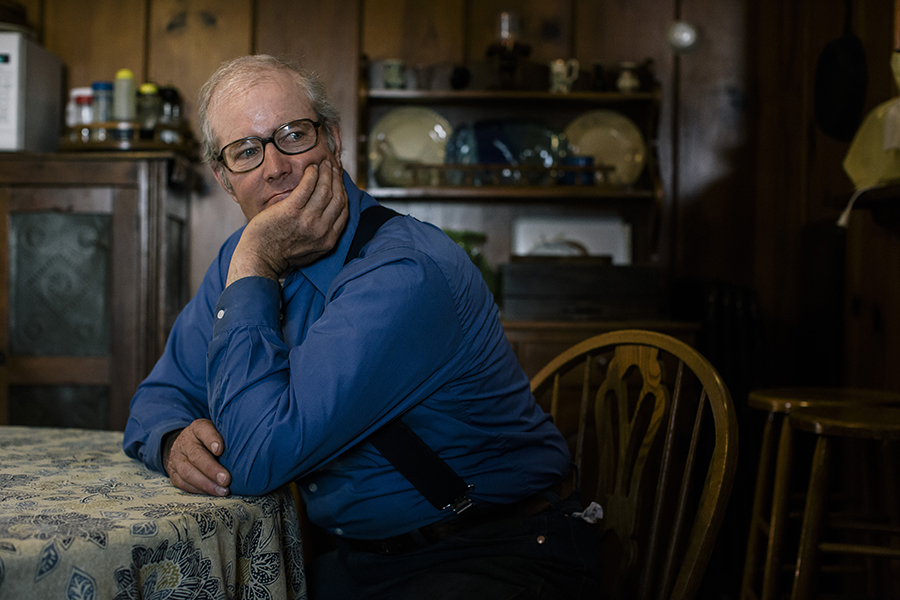
Salatin has long appealed to both left- and right-wing audiences.
Greg Kahn/The Washington Post/Getty
In that review of Holy Cows & Hog Heaven, I did object to some of Salatin’s spiel. I noted that he “argues unedifyingly that GMOs ‘violate God’s Genesis plan'” and that he “gratuitously lashes out at abortion doctors.” I dismissed these statements as “borderline offensive” marginalia in an otherwise edifying book.
Yet Salatin’s crackpot views on science and doctrinaire libertarianism are central to his message. No one who has followed his work for years should be surprised that he has emerged as a COVID-19 denier. In a March 16 post, he declared, “I want coronavirus,” because “I’ve been watching all the personal stories of the folks who have gotten it and the overwhelming testimony is pretty simple: a day of sniffles, another day of fatigue, then a couple of days of recovery, and life is back to normal.” He ended the piece like this:
Here at Polyface, we invite anyone who wants to super-charge their micro-biome to come out to the farm, roll around in the compost pile, walk barefoot through the pasture, pick up a chicken and rub her feathers—and take home 10 dozen eggs. Let’s get life into ourselves rather than death through sanitizers and anti-microbials.
In an October 8 blog post, he re-upped his stance. “Covid should not be a federal government issue,” he declared. “Are you tired of masks? Not a single scientific study shows their efficacy as currently worn.” (Actually, plenty of evidence suggests that widespread masking slows the virus’ spread and limits the severity of infections.)
Since then, he has switched from questioning masks to dismissing them outright. On November 15, he hosted 300 people at his farm, with “registrations filled in a couple of days with a looooong waiting list,” he boasted on his blog. “We did not wear masks; we hugged; we laughed—AND WE TURNED OFF OUR CELL PHONES.” Why did the cellphone move merit emphasis? The event featured a speaker positing that COVID-19 stems from the rollout of the 5G mobile network, and is a “result of too much EMF radiation”; turning off phones means stopping the spread of the infection. As for viruses, they’re just “garbage collectors to grab junk and take it out of our cells and to run around in the body warning ‘something bad’s coming; get ready,'” he opined. With coronavirus infections surging yet again, Salatin is using his influence to spout dangerous nonsense.

So where does the Newman–Salatin dispute leave the sustainable-farming movement? I think it has foregrounded two vitally important conversations that were scarce when I joined a small farm 15 years ago, and that have been too absent in my own writing.
For one, we need more real talk about the failed individual-family model of farming—especially for anyone without access to inherited land—and the search for new, more robust, and realistic alternatives.
The second is the need to highlight the deeply racist legacy of US agriculture, and show how racism is embedded in the movement to create an alternative to industrial agriculture. “What I miss in the US food movement is an urgent sense of history,” the author and activist Raj Patel wrote in 2016. “History about the soil on which local food is grown. About the blood of first nations and slaves in that soil. About the legacy of settler colonialism that lets some folk obsess over kale while those harvesting it can’t afford to buy it.”
Black farmers have been evicted from the land by a century of racist policies. By the early 20th century, nearly a million Black farmers owned 20 million acres of land, making up a seventh of all farms. Today, only about 36,000 of them remain, making up just 1.7 percent of the nation’s farm owners, and tending a scant 4.7 million acres—a nearly 90 percent loss of land. Neither Salatin’s homilies about the rugged individual nor his libertarian zeal has anything to offer to most young Black people looking to farm. Rather, his brand of libertarianism serves as a beard to justify the kind of white domination of the US economy that endures today.
Nowadays, Newman has ditched the go-it-alone approach and is pursuing a cooperative vision. The Sylvanaqua Farms website lays out the kind of operation he’s trying to build, funded in part through crowdfunding from Kickstarter and Patreon:
1. A mosaic of public and private lands serving as a base to produce wholesome food from health ecologies.
2. A vertically-integrated, employee-owned cooperative of farms, nurseries, mills, processors, retail outlets, and wholesale distributors.
3. Food available at greatly reduced prices without sacrificing ecological values, and agricultural opportunities open to more than just the most privileged members of society.
Newman is part of a rising generation of farmers of color rejecting old myths and creating new economic models. “A lot of new and young farmers of color are interested in tapping into ancestral practices which were largely communal and collaborative,” Ebony Gustave, who tracks the cooperative movement though her website, Cooperative Journal, told me. “Land ownership is hard to obtain for beginning farmers in general, but especially for farmers of color,” she added. “Collective land ownership can not only give farmers of color the opportunity to own land and gain economic independence, but also to start building their own communities in a society that has ostracized them.” Back in September, when she was a fellow at the National Sustainable Agriculture Coalition, Gustave organized an excellent webinar featuring Black farmers engaging in cooperative agriculture, which can be viewed here.
Newman offered a similar explanation for the emerging tendency to question a go-it-alone approach to farming. “I think marginalized people are better equipped to think of more innovative models for how sustainable agriculture can work than most of the white people who are incumbent in agriculture,” Newman told me. “People who are Black or Indigenous or gay, who are trans, are used to having to architect their entire existence around incumbent oppression.” He added: “When you see all these collective movements and cooperatives coming out of communities of color, it’s really not surprising, because people of color who want to get on the landscape don’t usually have the opportunity to go it alone.”
This article has been updated.
